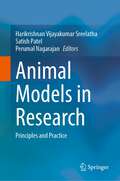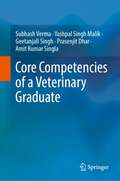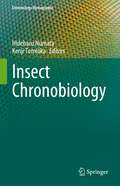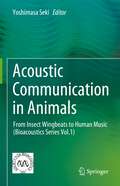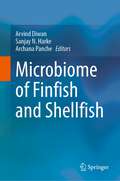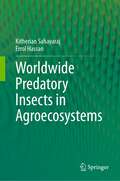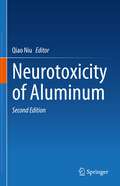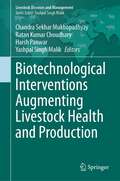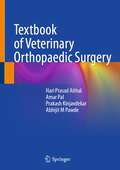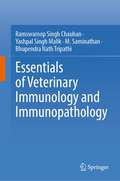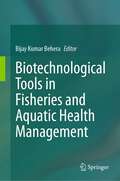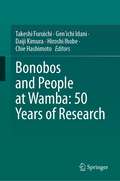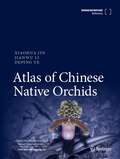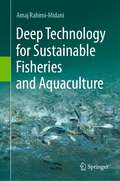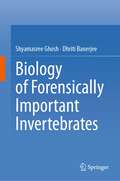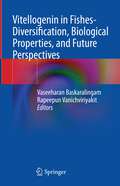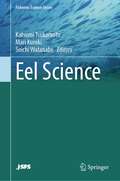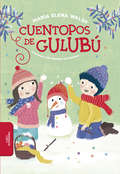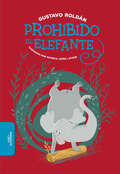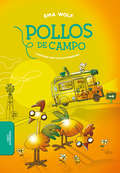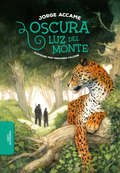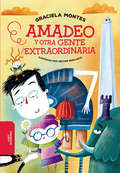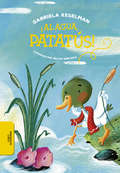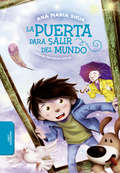- Table View
- List View
Animal Models in Research: Principles and Practice
by Harikrishnan Vijayakumar Sreelatha Satish Patel Perumal NagarajanThis book describes the development of animal models widely used in biomedical research using step-wise instructions and photographs. Showcasing a wide range of species from zebra fishes, birds, rodents, rabbits, dogs, and pigs, the book includes detailed methodology on how to work with these species and to develop various models. The animal models in neurology including stroke, Alzheimer’s disease, Parkinson’s disease, and Schizophrenia; Animal models in cancer research, sleep disorders, and cardiovascular diseases are described to meet the understanding of researchers who plan to replicate these models in their laboratories. In depth detailing on the development of targeted gene knockouts and transgenics, implantation models that are used in toxicology studies, and pharmacokinetic studies in pigs and dogs are a highlight. Further, the book describes pharmacologic, chemically induced, surgically induced, microbiologically induced, infectious models, models for neurobehavioral studies, oncology research, and pain research. The book has dedicated sections on anesthesia and analgesia and teaches procedures like venous cut-downs and cannulations in pigs and dogs, and endotracheal intubation, mechanical ventilation and thoracotomy in rodents and will serve as a self-training tool. Concepts in the field of animal model development are explained using examples. Sample size selection, study design, and statistical evaluation of experiments involving laboratory animals are explained to enable young researchers to practically understand the nuances. This book will be a valuable tool for academicians, students, scientists, and veterinarians and will benefit equally who are new to the field and who are already working with laboratory animals.
Core Competencies of a Veterinary Graduate
by Subhash Verma Yashpal Singh Malik Geetanjali Singh Prasenjit Dhar Amit Kumar SinglaThis book is an essential guide for veterinarians, veterinary faculty and policymakers for understanding the core competencies of a fresh veterinarian. The book briefly covers competencies in preclinical, paraclinical, and clinical subjects including anatomy, physiology, biochemistry, veterinary jurisprudence, animal management & welfare including nutrition and breeding, infectious and non-infectious diseases, disease epidemiology, diagnosis, and treatment, prevention, control and zoonoses, surgical and other clinical interventions. The book further includes other competencies, including biologicals, anti-mortem, and post-mortem inspection, certifications, applied one health aspects, review and analysis of scientific evidence, international trade and regulations, and organization of veterinary services. It also highlights the importance of effective communication, interpersonal skills, record keeping and management of a small veterinary hospital, health informatics, etc. The book breakdowns the must-have competencies of a global veterinarian into different topics and subtopics for easy comprehension and further learning. It enables the professional standard-setting & regulatory bodies and academicians in improved curricula designing and implementation and more importantly tries to bring uniformity in day one veterinary graduates’ competencies globally, enhancing the movement and employability of veterinarians across the world.
Insect Chronobiology (Entomology Monographs)
by Hideharu Numata Kenji TomiokaThis book reviews the physiological mechanisms of diverse insect clocks, including circadian clock, lunar clock, tidal clock, photoperiodism, circannual rhythms and others. It explains the commonality and diversity of insect clocks, focusing on the recent advances in their molecular and neural mechanisms. In the history of chronobiology, insects provided important examples of diverse clocks. The first report of animal photoperiodism was in an aphid, and the time-compensated celestial navigation was first shown in the honeybee. The circadian clock was first localized in the brain of a cockroach. These diverse insect clocks also have some common features which deserve to be reviewed in a single book. The central molecular mechanism of the circadian clock, i.e., the negative feedback loop of clock genes, was proposed in Drosophila melanogaster in the 1990s and later became the subject of the Nobel Prize in Physiology or Medicine in 2017. Thereafter, researches on the molecular and neural mechanisms in diverse insect clocks other than the Drosophila circadian clock also advanced appreciably. Various new methods including RNAi, NGS, and genome editing with CRISPR-Cas9 have become applicable in these researches. This book comprehensively reviews the physiological mechanisms in diverse insect clocks in the last two decades, which have received less attention than the Drosophila circadian clock. The book is intended for researchers, graduate students, and highly motivated undergraduate students in biological sciences, especially in entomology and chronobiology.
Acoustic Communication in Animals: From Insect Wingbeats to Human Music (Bioacoustics Series Vol.1)
by Yoshimasa SekiThis book is the first volume of the bioacoustics series published by the Society for Bioacoustics. This volume provides an overview of the advances and recent topics in acoustic communication in various animals. Most animals produce vibrations and sounds by moving their body parts, including vocal organs. These sounds can be research targets of bioacoustics studies. How animals use these sounds, especially in inter-individual relationships, is the focus of this volume, “Acoustic Communication in Animals”. The authors’ expertise varies from molecular biology, neurobiology to psychology, and human brain imaging. Their research subjects range from invertebrates to humans. Despite the variety of topics, chapters are developed under the consideration of ethology and evolution. Readers will recognize the profundity of the topics in each chapter. In addition, the view and understanding of natural sound sequences produced by animals can vary among different cultures. Research from Japan and regions that have been underrepresented in previous literature can offer new ideas and unique perspectives in the study of bioacoustics. Readers can grasp the progress of this research field in a broad range of species in one book. The book presents multi- and interdisciplinary topics and appeals to researchers and students in fields including psychology, physiology, zoology, ethology, and neurosciences.
Microbiome of Finfish and Shellfish
by Arvind Diwan Sanjay N. Harke Archana PancheThis book helps us to understand the importance of the microbiome associated with finfish and shellfish inhabiting different locations and varied environmental and biological situations. It covers modern molecular tools for identifying microbiome composition and their precise identification at the species level. The book also covers the molecular structural composition of individual microbes, metabolite resources from microbiome species, their functional properties, and production aspects. Notable, the book covers the microbiome applications in the gut systems of finfish and shellfish to the digestion, nutrition, growth, reproduction, immune system, and vulnerability of the host to diseases. It also reviews diversity and functional properties, relationships with diseases, health status, data on species-specific metagenomics, and probiotic research. It highlights the relevance of microbial communities for the development of new and innovative bio-products to build bio and pharmaceutical industries, including aquaculture. This book is an invaluable source for researchers and professionals involved in fishery science, fisheries and aquaculture, fish biotechnology, and fish microbiology and pathology
Worldwide Predatory Insects in Agroecosystems
by Kitherian Sahayaraj Errol HassanThis book brings out the world record of various predatory insects and their role in pestiferous insect management in a safer manner. The main focus of the book is to address the ecological and environmentally safe methods of managing pests of various crops. The utilization of various types of chemical pesticides for our crop protection and food production leads to environmental concerns and health hazards to plants and animals. This book mainly focuses on the distribution and diversity of various predatory insects in different crops. It also sellout the bionomics, biological control potential at a laboratory, controlled fields and natural conditions. Moreover, mass production technology and environmental safety aspects are also highlighted in various chapters. This book is of interest and useful to undergraduates, post-graduates, research scholars and doctoral candidates, extension workers, and agricultural professionals, and also a valuable source of reference to the relevant researchers and students in the region.
Neurotoxicity of Aluminum
by Qiao NiuThis book reviews the scientific literature and the authors’ own research linking aluminum neurotoxicity with cognitive impairment and Alzheimer’s disease (AD). It focuses on aluminum levels in the brain, region-specific and subcellular distribution, its relation to neurofibrillary tangles and amyloid beta—the pathological features of AD, and the possible mechanism of aluminum inducing these pathological features. Further, the book stresses the importance of aluminum’s complex speciation chemistry in relation to biology, and details aluminum’s mechanism in oxidative stress and cell death, especially in connection with apoptosis and necroptosis. The electrophysiological variation and synaptic plasticity induced by aluminum are covered, while the metal’s debatable role in AD and the cross-talk between aluminum and genetic susceptibility are also discussed, and more recently the relationship between aluminum-induced epigenetic modification on DNA and non-coding RNAs and neuron death and synaptic impairment.The second edition updates eight chapters according to the most recent researches. Content about aluminum-induced AD-like pathological features, neurotoxic effects of aluminum and aluminum alloy nanoparticles(TBD) and alumina nanoparticles induced neurotoxic and neurodevelopmental toxic effects is also added. In closing, this book provides readers with a systematic summary of aluminum neurotoxicity.
Biotechnological Interventions Augmenting Livestock Health and Production (Livestock Diseases and Management)
by Chandra Sekhar Mukhopadhyay Ratan Kumar Choudhary Harsh Panwar Yashpal Singh MalikThis book comprehensively discusses the applications of molecular genetics, functional and structural genomics, and proteomics vis-a-vis bioinformatics, artificial intelligence, and robotics in livestock healthfulness and productivity. It reviews the biotechnological approaches in veterinary sciences for increasing productivity and resistance to disease. The book emphasizes the approaches based on artificial intelligence to analyze the data collected on animals, pathogens, and their environment. It underscores artificial intelligence applications in disease diagnosis, epidemiological studies, and detecting biological phenomena, including heat-detection, pregnancy, docility, and infections. Further, the book examines the genomics and proteomics approaches for understanding the gut microbiota and the role of pathogen-host interactions in animal health and disease. Lastly, it explores both pathogenic and non-pathogenic microbial transfer between humans, animals, and the environment across one health spectrum.
Textbook of Veterinary Orthopaedic Surgery
by Hari Prasad Aithal Amar Pal Prakash Kinjavdekar Abhijit M PawdeThis textbook emphasizes the fundamentals of bone fracture and its fixation, including advanced techniques of osteosynthesis in both small and large animals. Various fracture fixation techniques and devices have been described in simple language with the help of sketches and photographs. The chapter on the basic considerations in fracture fixation narrates bone structure and types, bone development and growth regulation, types of fracture and fracture healing, first aid and emergency treatment, selection of fracture fixation technique, anesthetic management, and fracture fixation implants and instruments. The book highlights principles of different external, internal, and external skeletal fixation techniques. It also presents various basic and advanced techniques used to manage specific fractures in different bones, separately for small and large animal patients. It also includes specific topics like fracture fixation in young, osteoporotic, and avian bones, open fracture management, bone grafts and scaffolds, and fracture fixation complications. Towards the end, the book elucidates miscellaneous but essential topics in veterinary orthopedics such as metabolic bone diseases, antebrachial bone deformities, joint luxations, arthritis, common tendon, and ligament injuries, bone tumors, and physiotherapy and rehabilitation of patients. This textbook is essential reading for veterinary students, practitioners, and researchers working in veterinary orthopedic surgery.
Essentials of Veterinary Immunology and Immunopathology
by Ramswaroop Singh Chauhan Yashpal Singh Malik M. Saminathan Bhupendra Nath TripathiThis textbook for graduate veterinary students provides basic concepts of veterinary immunopathology with particular reference to immunopathogenesis. The initial chapters provide up-to-date knowledge on important aspects of immunology, immunodeficiency disorders, hypersensitivity reactions, and autoimmune disorders of various animal species. The book examines different natural and synthetic immunomodulatory products that can modulate the immune system of animals. It discusses the immunopathogenesis and immunopathology of multiple diseases and immunopathological disorders in diverse animal species, including cattle, buffalo, sheep, goat, swine, equine, and laboratory animals. The book also covers the immunopathology of various body systems, including lungs, reproductive system, enteric system, mammary gland, joints, kidneys, and skin. It provides clinical manifestations that are useful in diagnosing immunopathological conditions. The book presents a highly informative text with highquality gross and microscopic photographs, diagrammatic presentations of immunopathological disorders and techniques, making it useful in both classrooms and professional training courses for students, researchers, and professionals alike.
Biotechnological Tools in Fisheries and Aquatic Health Management
by Bijay Kumar BeheraThis edited book is focused on SDG 14: life below water. This book covers all aspects of fish biotechnology and health management. A detailed description is provided of CRISPR Cas9 technology application in the development of superior variety of fish with better growth, disease resistance, etc., accompanied by numerous helpful photographs and schematic diagrams. In addition, recent developments in nanotechnology and its application in fisheries production enhancement have been discussed. Further, topics includes, probiotics, immunostimulants, fish genetic markers, bioremediation, metagenomics, transgenerational immune priming, application of cell culture in fisheries and nano-biosensor application on fish disease diagnosis, pollution monitoring, etc. are provided in details. . The book is helpful for researchers, teachers, students, farmers, and entrepreneurs in utilizing the knowledge on recent advancements in different aspects of fish genetics and biotechnology for future research and aquaculture production enhancement.
Bonobos and People at Wamba: 50 Years of Research
by Takeshi Furuichi Gen'Ichi Idani Daiji Kimura Hiroshi Ihobe Chie HashimotoThis book reviews all the findings about bonobos and the local people of Wamba village in the Luo Scientific Reserve in the Democratic Republic of the Congo over the last 50 years. In 1973, Takayoshi Kano, a Japanese primatologist, traveled across a vast area of the Congo Basin with a bicycle and found Wamba village to be a promising site to start his first studies on wild bonobos. Since then, many researchers from Japan and all over the world have been working at Wamba, now the longest standing study site, to uncover various aspects of the ecology and behavior of this most recently identified great ape species. The researchers study bonobo behaviors and carry out various activities for the conservation of bonobos. They also conduct anthropological studies of local people who live with bonobos and believe them to be distant relatives from the same family, living in the forest. This book is published in commemoration of 2023 marking the 50th year of study. The main chapters are contributed by active researchers studying bonobos and the local people at Wamba. The book also includes contributions from various eminent researchers who have carried out short-term research or have supported research at Wamba, which helps place these studies of bonobos in a broader primatological or anthropological perspective. This book will be a useful resource for professional researchers in primatology and anthropology, as well as graduate or undergraduate students interested in these research fields.
Atlas of Chinese Native Orchids
by Xiaohua Jin Jianwu Li Deping YeThis book updates taxonomy information of orchids in China. China is one of the countries with the richest biodiversity. In China, all five subfamilies of Orchidaceae are represented, about 1600 orchid species in 198 genera. All orchids are rare and endangered plants. They are among the flagships for biological conservation, listed in CITES appendix I or II. This book provided an updated classification system of Orchidaceae with newly recorded and published species in China and new combinations. 1026 species in 157 genera of native species in China are included, about half of which are newly recorded or published species in China in the last two decades. Indexes to genera and species are included. For each species, one to four photos, most of which were taken by the authors, are utilized to illustrate habitats, morphological characters, and phenology. Furthermore, the geographic distribution of them also demonstrated in a map. This book can be used as a reference for researchers working on Orchidaceae, as well as practitioners in the horticulture community.
Deep Technology for Sustainable Fisheries and Aquaculture
by Amaj Rahimi-MidaniThis book uses real-world examples from the aquaculture industry to demonstrate how deep technology is assisting farmers and vulnerable communities. Works conducted by Poseidon-AI (a deep tech company involved in the aquaculture sector) in different countries are presented as case studies to show the positive impacts of deep tech involvement in the aquaculture sector. Primary industries, such as fisheries and aquaculture, rely heavily on labor. Furthermore, the manual practices of these farming methods increase material waste and reduce yields, resulting in higher costs and lower revenues. Poikilotherms make up the majority of aquatic animals, and environmental changes have a significant impact on them. This means that, due to climate change, farming of these animals cannot continue in the same way that it has for centuries. Artificial intelligence, machine learning, image processing, sensing, and automation are approaches that can assist these farms in dealing with rapid environmental changes while also assisting farmers in growing their businesses sustainably. This book is of interest to climate change scientists, entrepreneurs, investors, civil workers, and policymakers. Furthermore, the book is a great complimentary material for graduate students of fisheries, aquaculture, ecology, soil science, water management and environmental sciences. All national and international policymakers working in implementation of UNSDGs and sustainability, will find this book a useful read.
Biology of Forensically Important Invertebrates
by Shyamasree Ghosh Dhriti BanerjeeThis book emphasizes the important role of invertebrates in forensic sciences in the detection of crimes, determining the time and place of death, estimating the minimum Post-Mortem Interval (PMI), and determining the cause of death. The initial chapter discusses the forensically essential invertebrates, especially flies under Order Diptera. Further, the book highlights the importance, biology, taxonomy, and biodiversity of flies under Order Diptera with forensic importance. It also discusses the Cuticular HydroCarbons (CHC) and spectrometry-based studies reported from flies and larvae of forensic importance. It further reviews the importance of DNA barcoding in molecular taxonomy-based studies on forensic flies through understanding, identification, and grouping the organisms. Towards the end, this book presents the applications and limitations of forensic entomology in cases of animal cruelty to a veterinary professional.
Vitellogenin in Fishes- Diversification, Biological Properties, and Future Perspectives
by Vaseeharan Baskaralingam Rapeepun VanichviriyakitThis book provides basic and advanced information on vitellogenin in fish. The proposed book discusses the history of vitellogenin, previtellogenesis, their diversification and classification in fishes, and tools for their identification and characterization. Further, their functional aspects in oogenesis and its regulatory mechanism, role as the immunocompetent molecule, and reproductive strategies are discussed. The book further examines vitellogenin as a hormone and biomarker, its related egg yolk proteins, and its mechanism on molecular cloning and induction. In addition, the book discusses its role in the disruption of the endocrine system in fish, its biological activities, its multivalent mechanism in marine and freshwater fishes, and its impact on the growth of ornamental fishes. Moreover, this book elaborates on the multiple vitellogenin genes, each with unique promoter regions and varying sensitivity to induction by estradiol, and multiple Vtg proteins themselves, with variable degrees of post-translational modification. As such, this book is helpful for researchers and students interested in the reproduction of fishes and reproductive biology.
Eel Science (Fisheries Science Series)
by Katsumi Tsukamoto Mari Kuroki Soichi WatanabeThis book is a compilation of eel research and fish migration studies for more than 40 years showing the research history and recent advances in eel studies. Dr. Katsumi Tsukamoto, the esteemed editor of this book, has been actively involved in eel research as one of the leading scientists in the world for a long time, and he and his team successfully collected the fertilized eggs and spawn-condition adult eels from the wild for the first time in the world. This book compiles the essentials of the scientific findings obtained by the editor and his colleagues and reviews the latest references of eel science. Knowledge and information in the book such as a spawning area survey, research on artificial production of glass eels, the discovery of a new species, etc. will attract the reader’s interest, as these are written based on the authors’ experiences. Readers can obtain a comprehensive understanding of eels from various aspects of eel science including the cultural and socio-economic importance of eels and valuable scientific information using state-of-the-art approaches. The book also endeavors to contribute to the conservation of eel species, some of which have been classified as endangered by the IUCN and to promoting harmonious coexistence between humans and nature.
Algunos son animales
by David WapnerLos dieciséis cuentos que componen Algunos son animales son bien distintos. Distintos a otros y distintos entre si. Un poco locos, un poco absurdos, un poco históricos. Todos maravillosos. David Wapner nos devuelve la sorpresa en cada una de sus historias porque todas son igual de inesperadas: un torero que busca a Marcelo, su toro, por las calles del barrio; un perro que se cree hombre y no perro. Este libro nos brinda un viaje fascinante, y una lectura tan entretenida que resulta imposible dejarla para después.
Cuentopos de Gulubú
by María Elena WalshCuentos disparatados, con personajes sorprendentes. Los lectores podrán conocer la historia de Don Fresquete, Murrungato del zapato, La Plapla, Historia de una princesa, su papá, y el príncipe Kinoto Fukasuka, el cuento Un enanito y siete Blancanieves, la Historia de un domingo siete y la de La regadera misteriosa, entre otras. En Cuentopos de Gulubú vas a conocer historias muy divertidas con princesas, animales y objetos maravillosos, que suceden en el bosque, en castillos, en la escuela y en el fondo del mar. En Gulubú pasan cosas tan sorprendentes que cuando termines de leer este libro lo vas a querer empezar de nuevo.
Prohibido el elefante
by Gustavo RoldánEstos cuentos de Gustavo Roldán nos acompañan una vez más en un viaje inolvidable que convierte el paisaje del monte chaqueño en escenario de aventuras impensadas. Zorros y tigres, pulgas y sapos, vizcachas y monos son solo algunos de los animales que se reúnen en estas páginas. Los vemos buscar formas en las nubes, hacerse bromas unos a otros, recordar historias compartidas e imaginar cómo será aquello que no conocen. Junto a ellos, descubrimos un mundo que desborda de palabras. Palabras que salpican como el agua, que sacuden las copas de los árboles, que soplan como el viento.
Pollos de campo
by Ema WolfEn este libro, Ema Wolf desarrolla con maestría una historia con altas dosis de intriga y humor. Esta novela ya es un clásico de la literatura juvenil argentina. Se tradujo a varios idiomas, recibió importantes premios y una mención especial en la lista de The White Ravens. La elástica Mimí, el Oso, el Mago Jesús y la Gran Rita se separan accidentalmente de su troupe. Una noche de lluvia, justo antes de salir en busca del circo Augustus, encuentran y adoptan a Pedro, un huérfano que ha perdido a sus hermanos. Esta delirante caravana vivirá aventuras desopilantes, encontrará nuevos amigos y algunas sorpresas mientras recorre las rutas improvisando funciones para sobrevivir.
Oscura luz del monte
by Jorge AccameCon su prosa aguda, en estos cuentos Jorge Accame explora el lado salvaje del ser humano. Sin dudas, una excelente elección para captar a los jóvenes lectores. La realidad se transforma cuando nos acercamos a la naturaleza. Estos relatos se adentran en el corazón del monte y conducen a los hombres por caminos inesperados y perturbadores. Un mono salvaje, un mensaje del más allá, unos ojos amarillos que brillan en la oscuridad, vinchucas que se amontonan en torno al catre de quien intenta dormir, una carcajada siniestra que brota en medio de la selva y una presa que se convierte en cazador son algunos de los inquietantes senderos por los que nos lleva este libro.
Amadeo y otra gente extraordinaria
by Graciela MontesEn estos relatos hay personajes asombrosos. Amadeo no es exactamente un gigante, pero casi... ¡y llora gladiolos! Luis y su perro Cuis se enfrentan al temible Monstruogrís. Carloncho es un gato que sabe jugar al truco y se transforma en estrella de circo, y Carmela tiene un problema: ¡las palabras se le vuelven cosas! Este libro tiene cuentos cortos, ideales para primeros lectores. Fue distinguido con el Premio Lazarillo (Accésit) que otorga el Instituto Nacional del Libro Español e incluido en los recomendados por White Ravens. Graciela Montes creó estos seres peculiares, cuyas historias todos querrán leer y releer.
¡Al agua Patatús!
by Gabriela KeselmanGabriela Keselman escribió estos tres cuentos cortos para aquellos pequeños lectores que sienten que, de a ratos, crecer es verdaderamente fácil, y de a ratos, verdaderamente difícil. ¡Atención los castores que se comen las uñas! ¡Alerta para todas las ratoncitas que sueñan con hamacarse hasta el cielo! ¡Bienvenidos los patos a los que no les gusta el agua! Con estos relatos, dejarán atrás el aburrimiento, volarán alto y descubrirán que el ingenio puede ser más grande que el miedo.
La puerta para salir del mundo
by Ana María ShuaAnimate a descubrir estas dos historias de Ana María Shua. Relatos que abren la puerta a la aventura con humor, sensibilidad e ingenio. En este libro vas a conocer el Mundo Donde Todo es Verdad. Allí nadie puede decir mentiras, ni siquiera de las chiquitas. Todo lo que uno inventa se vuelve verdadero... Y eso puede ser bastante asombroso, ¡imaginate...! También hay una pluma de paloma que cumple deseos. Vos, ¿qué pedirías? Algunos dicen que es preferible no cumplirlos todos. ¿Será verdad?
